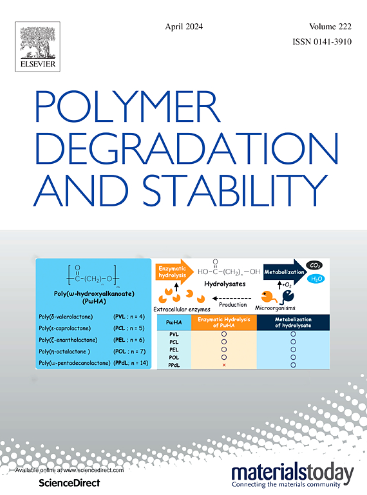Room-temperature processed epoxy-silica nanocomposite coating for improved hardness and UV protection of polycarbonate
IF 6.3
2区 化学
Q1 POLYMER SCIENCE
引用次数: 0
Abstract
A nanocomposite coating consisting of epoxy resin and silica nanoparticles was developed using a simple in situ sol–gel process that operates efficiently near room temperature. This coating, which strongly adheres to polycarbonate (PC), doubles the hardness of PC while maintaining its transparency. Solid-state NMR confirmed the formation of a silica network through the hydrolysis and condensation of tetramethoxysilane and aminopropyltriethoxysilane (APTES) as silicon source. Scanning electron microscopy revealed a uniform dispersion of 20 nm silica nanoparticles. The APTES molecules function as cross-linkers, strengthening the matrix–filler adhesion and contributing to the reinforcement of the coating. Furthermore, the coating effectively suppressed yellowing of PC during 24 days of UV irradiation. The two-trace two-dimensional correlation mapping technique based on Fourier transform infrared microscopy showed reduced photodegradation at both the surface and deeper layers of the PC. This energy-efficient and scalable technique is promising for industrial applications.

室温处理的环氧-二氧化硅纳米复合涂层,用于提高聚碳酸酯的硬度和紫外线防护
采用简单的原位溶胶-凝胶工艺制备了一种由环氧树脂和二氧化硅纳米颗粒组成的纳米复合涂层,该涂层在室温下有效地工作。这种涂层与聚碳酸酯(PC)紧密结合,在保持透明度的同时,硬度增加了一倍。固体核磁共振证实了四甲基氧基硅烷和氨丙基三乙基氧基硅烷(APTES)作为硅源通过水解缩合形成硅网。扫描电镜显示20 nm二氧化硅纳米颗粒均匀分散。APTES分子作为交联剂,增强了基体与填料的附着力,有助于涂层的增强。此外,涂层在24天的紫外线照射下,有效地抑制了PC的黄变。基于傅里叶变换红外显微镜的双迹二维相关映射技术表明,PC表面和深层的光降解都有所减少。这种节能且可扩展的技术在工业应用中很有前景。
本文章由计算机程序翻译,如有差异,请以英文原文为准。
求助全文
约1分钟内获得全文
求助全文
来源期刊

Polymer Degradation and Stability
化学-高分子科学
CiteScore
10.10
自引率
10.20%
发文量
325
审稿时长
23 days
期刊介绍:
Polymer Degradation and Stability deals with the degradation reactions and their control which are a major preoccupation of practitioners of the many and diverse aspects of modern polymer technology.
Deteriorative reactions occur during processing, when polymers are subjected to heat, oxygen and mechanical stress, and during the useful life of the materials when oxygen and sunlight are the most important degradative agencies. In more specialised applications, degradation may be induced by high energy radiation, ozone, atmospheric pollutants, mechanical stress, biological action, hydrolysis and many other influences. The mechanisms of these reactions and stabilisation processes must be understood if the technology and application of polymers are to continue to advance. The reporting of investigations of this kind is therefore a major function of this journal.
However there are also new developments in polymer technology in which degradation processes find positive applications. For example, photodegradable plastics are now available, the recycling of polymeric products will become increasingly important, degradation and combustion studies are involved in the definition of the fire hazards which are associated with polymeric materials and the microelectronics industry is vitally dependent upon polymer degradation in the manufacture of its circuitry. Polymer properties may also be improved by processes like curing and grafting, the chemistry of which can be closely related to that which causes physical deterioration in other circumstances.
 求助内容:
求助内容: 应助结果提醒方式:
应助结果提醒方式:


